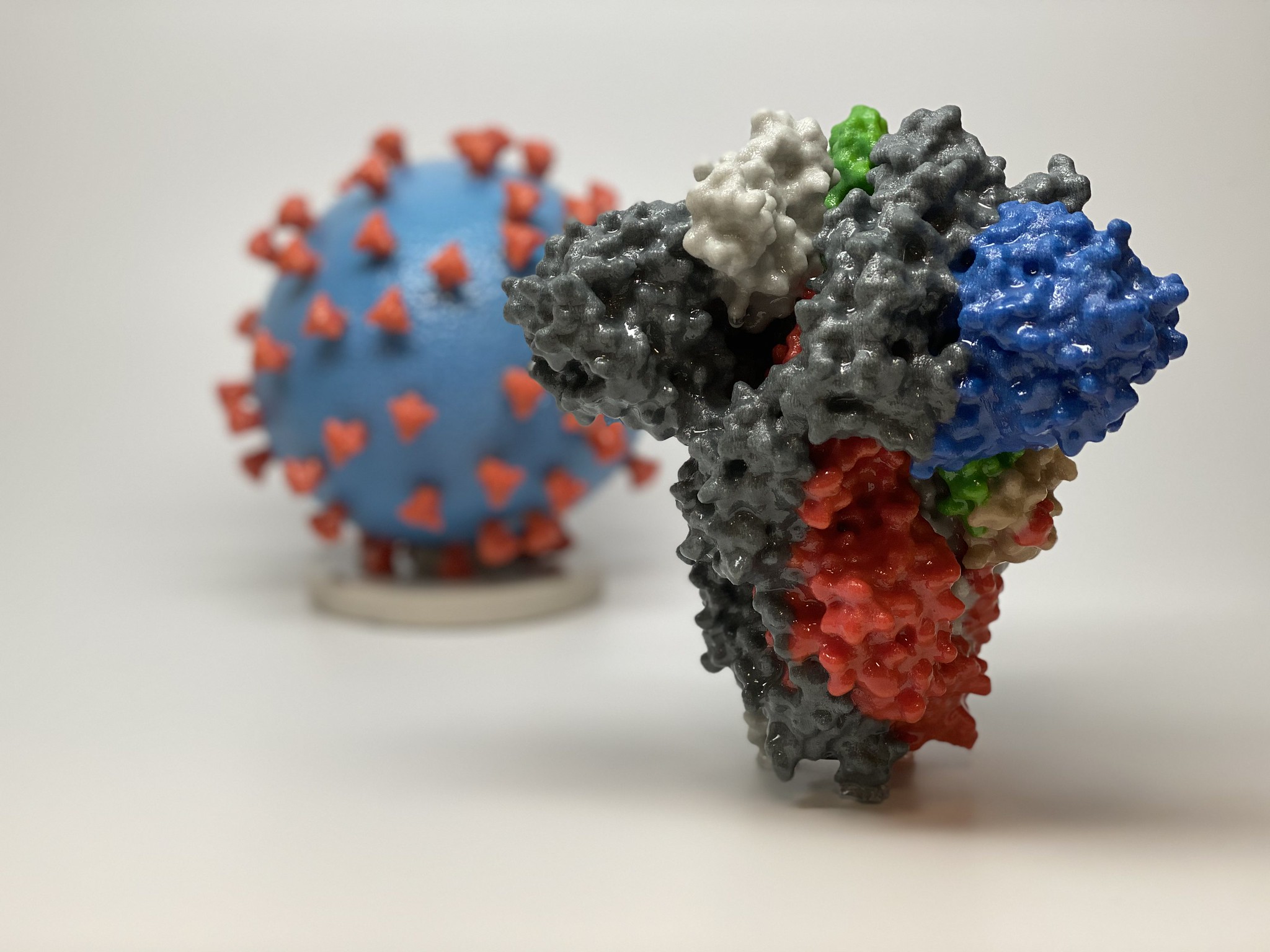‘Alarming’ Sevenfold Increase in Stevens-Johnson Syndrome Linked to COVID-19 and Vaccine
Researchers with the burns unit at Concord Repatriation General Hospital in Australia saw two to four cases of SJS, or toxic epidermal necrolysis (TEN), per year prior to COVID-19. In the first six months of 2022 alone, the same burn center observed a sevenfold rise in cases.
 |
| This image shows a 3D print of a spike protein of SARS-CoV-2—the virus that causes COVID-19—in front of a 3D print of a SARS-CoV-2 virus particle. (Courtesy of NIAID/RML) |
Researchers said the rarity of the condition and presence of medications known to trigger the disease make the link difficult to prove, but the rapid rise in cases since the beginning of the pandemic and vaccine rollout is “alarming.”
SJS/TEN (Stevens-Johnson syndrome/toxic epidermal necrolysis) is a severe hypersensitivity condition where the skin develops rashes, blisters, and peels forming painful areas that resemble a severe hot water burn. Mucous membranes, including the eyes, genitalia, and mouth, are often affected or severely damaged, leading to sepsis, pneumonia, infection, or death.
Although SJS and TEN were once considered separate conditions, they are now part of the same disease—with SJS representing the less severe end of the disease spectrum and TEN representing the most severe.
Medications, including epilepsy medicines, antibiotics, and anti-inflammatory painkillers, are the chief cause of SJS/TEN, but certain viruses and vaccines can also cause the condition. Due to its potentially fatal nature, SJS/TEN is considered a medical emergency, and patients are treated in burn units.
Researchers’ 3 Theories for Sudden Rise in SJS/TEN Cases
The researchers proposed three theories for the sudden increase in SJS/TEN cases.
Virus-Induced
The first theory is that the SARS-CoV-2 virus may induce SJS/TEN by directly binding to receptors that trigger a T-cell-mediated response. Other viruses known to cause SJS/TEN include the herpes simplex virus, Epstein-Barr virus, and influenza.
Vaccine-Induced
A second theory is that COVID-19 vaccines may directly bind to cell receptors that trigger SJS/TEN and influence the body’s T-cell immune response initiating SJS/TEN. This T-cell response peaks at seven and 28 days post-vaccination, consistent with the observed cases.
Of the three cases attributed to vaccination in the study, two patients had received an mRNA vaccine, and one received a viral vector vaccine within a month of developing SJS/TEN. Researchers identified eight other cases of SJS following COVID-19 vaccination in published literature—four were associated with mRNA vaccines, three with viral vector vaccines like AstraZeneca and Johnson & Johnson, and one with a whole virus vaccine.
According to the U.S. Vaccine Adverse Event Reporting System (VAERS), 198 cases of SJS/TEN following COVID-19 vaccination were reported between Dec. 14, 2019, and June 23, 2023. Historically, VAERS has been shown to report fewer than 1 percent of actual vaccine adverse events, which means other cases of SJS/TEN may have occurred but were unreported.
Threshold Lowering
The third theory proposed by the authors is that developing a COVID-19 infection or receiving a vaccine “primes” the immune system, lowering the threshold for a drug to trigger SJS/TEN. Without this “priming,” the drug would otherwise not cause the condition, as noted in each of the following cases:
- A 26-year-old male received two previous doses of a viral vector vaccine and one mRNA vaccine dose. After experiencing vaccine-associated symptoms, he took paracetamol and ibuprofen and developed SJS. He had previously taken both medications with no adverse effects.
- A 60-year-old female had COVID-19 six weeks before the onset of SJS/TEN. During that time, she received allopurinol for gout and experienced a reaction, despite taking the drug in the past with no ill effect. The woman had received two doses of an mRNA vaccine.
- A 45-year-old male developed a reaction to a seizure prophylaxis drug. He was diagnosed with COVID-19 four weeks before developing SJS/TEN and was triple vaccinated with an mRNA vaccine.
- A 53-year-old female received a viral vector vaccine three weeks before the onset of SJS/TEN. She was quadruple vaccinated with viral vector and mRNA vaccines and reacted to medications received for a life-threatening scleroderma complication.
Regulatory agencies in the United States and abroad have not acknowledged the potential link between SJS/TEN and COVID-19 vaccines or studied the ability of the virus or vaccine to prime the immune system. The study’s authors say more research should be done to investigate the impact viruses like SARS-CoV-2 have on immune-mediated disorders such as SJS/TEN.
Read more articles related to vaccine: Vaccine series.
Related:
Tylenol and other acetaminophen brands might cause severe skin problems like Stevens-Johnson syndrome
Z-Dtox Supplement
Your immune system can be weakened by over 300 different primary immunodeficiency disorders, poor diet, lack of sleep, and adverse reactions to various vaccines.
That’s where Z-DTOX comes in! Z-Dtox is Dr. Zelenko’s proprietary combination of NAC, EGCG, Zinc, Vitamin C, and Vitamin D.
Ingredients:
- Epigallocatechin gallate (EGCG) is an extract of green tea and is a powerful zinc Ionophore (zinc delivery system).
- N-acetyl cysteine (NAC) is a supplement form of cysteine. It may prevent blood clots and is an antioxidant.
- Zinc is critical for immune cell development. Dozens of different enzymes in the body rely on zinc.
- Vitamin C is an essential nutrient involved in the repair of tissue and the enzymatic production of certain neurotransmitters.
- Vitamin D is a group of fat-soluble secosteroids responsible for increasing intestinal absorption of calcium, magnesium, and phosphate, and many other biological effects.
Note: To get 5% OFF, please use this coupon code: drfrancis






.png)

I would suggest the adjuvants are responsible for triggering SJS. My daughter came down with it after being fitted for metal braces, and then took an antibiotic. Prior to the braces, there were no issues with medications. The metal was a catalyst. She tested negative on all allergy tests except thiomersal.
ReplyDeleteThe catalyst you speak of is called a Hapten
DeleteAre you speaking of metal braces in the mouth as placed by the orthodontist?
Delete